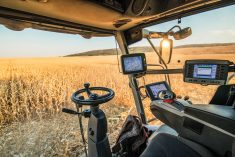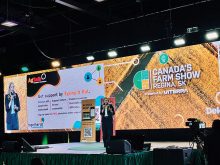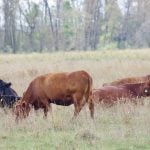The good bugs are working south of the border to control the bad weeds.
Biocontrol agents – a.k.a. beetles – have shown good success, said Derrill Fick, weed control officer for Ward County, near Minot, North Dakota, in a presentation at the recent annual general meeting of Manitoba Weed Supervisors.
The brown spurge flea beetle species, Apthona lasertosa, and its black cousin, nigriscutis, used extensively in North Dakota for almost two decades, have been joined by the red-headed leafy spurge stem borer or Oberea erythrocephala. Unlike the Apthona varieties, which attack the roots, the latest beetle species goes straight for the stem.
Read Also

Fibre and fabric art shines in Manitoba
Manitoba’s fibre and textile artists are showing off their wool, thread and other material skills in MacGregor in November 2025.
“It lays its eggs on the stem of the spurge plant. It doesn’t do anything to the root system,” said Fick. “The little larvae hatch out, and they eat out the spurge plant itself.”
That helps in areas with predominantly sandy soils, because in that soil type, spurge roots tend to be farther down where the root-eating bugs have trouble reaching the fine hairs that they prefer.
“This Oberea thing, it’s kind of a stop-gap method to control seed production,” he said. “It doesn’t do anything to the roots, but it stops seed production.”
The Oberea bugs have taken up residence in the state, but the Aphthona species is much more common.
After a number of bumper years for the bugs, Fick said wet summers have put a damper on spurge beetle numbers in the last four to five years. Collection is normally done in June, he added, and it helps if the weather is warm and dry.
BEETLE ROUNDUP
From 2001-03, when 30 million beetles were gathered per year, 70 high school students and teachers were hired to catch bugs, both brown and black, with sweep nets. The bugs were chilled and packaged in ice-cream containers, then distributed “to whoever wanted them” or placed by weed officers at problem sites marked with red flags.
Each flag had 20,000 to 30,000 insects, he said, pointing to photos of areas where 20-to 30-year-old spurge infestations were virtually wiped out. The bugs stick around to catch freshly germinated spurge plants from the weed seed bank, and multiply, too. That means their offspring can be caught and taken to a fresh patch.
To speed collection, they sometimes attach a splash plate collector with a hopper onto an ATV to catch the beetles in larger quantities than is possible with sweep nets.
THISTLE CONTROL
Other bugs are being tried to control Canada thistle. Workshops to distribute Ceutorhynchus litura and Larinus planus, two kinds of weevils that damage the skin of the plant and create opportunities for secondary bacterial infections, have been organized in recent years. Urophora cardui, a tiny fly that eats thistle, is also being used.
The bugs were originally purchased from companies in Montana. In the early 1990s, the beetles cost an astronomical $1 per bug, but prices have since dropped dramatically.
Now, it’s possible to buy a package of 50,000 beetles for about $150, said Fick. At least 20,000 beetles need to be dropped “in a pile” at each site to be effective. Bugs shouldn’t be collected from the site until the second year to give them time to become established.
Larinus minutus, known more commonly as the spotted knapweed weevil, is also being tried.
Last year, the state’s biocontrol activities included five spurge beetle field days, and two thistle workshops, where 11,000 galls (containing larvae and pupae) were handed out.
North Dakota also operates a certified weed seed-free forage program, where a weed control officer goes out to a field and checks for the presence of weeds. If the field is clean, and the haying is done within 10 days (before weeds would have had time to go to seed), the hay gets a stamp.
Certified forages only are allowed for use on trail rides in state and national parks, as well as on government land, he added. Growers benefit by being able to charge a premium for the hay, and the certified status allows for easier interstate commerce.
Last year, 8,000 bales were certified and tagged by 16 different producers.
Ward county also uses GPSequipped data loggers on sprayers which record the coordinates of every spray site for future reference, said Fick. daniel. [email protected]
———
“Itdoesn’tdoanythingtotheroots,butitstopsseedproduction.”
– DERRILL FICK














